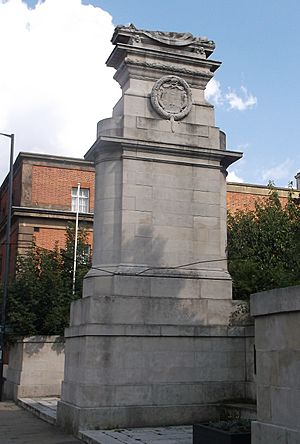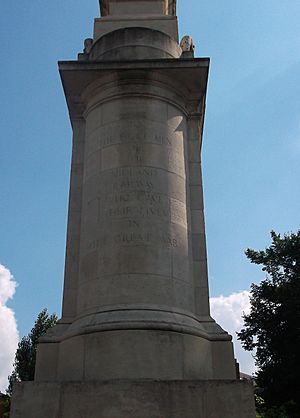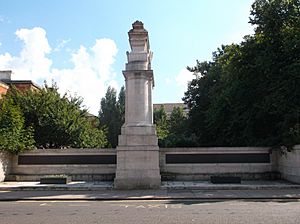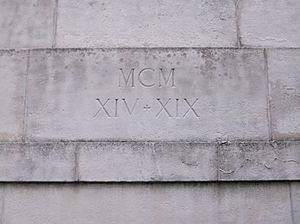Midland Railway War Memorial facts for kids
Quick facts for kids Midland Railway War Memorial |
|
|---|---|
| United Kingdom | |
 |
|
| For employees of the Midland Railway killed in the First World War | |
| Unveiled | 15 December 1921 |
| Location | 52°54′56″N 1°27′54″W / 52.91550°N 1.46490°W Midland Road, Derby
|
| Designed by | Sir Edwin Lutyens |
| Commemorated | 2,833 |
|
TO THE BRAVE MEN OF THE MIDLAND RAILWAY WHO GAVE THEIR LIVES IN THE GREAT WAR
|
|
|
Listed Building – Grade II*
|
|
| Official name | Midland Railway War Memorial |
| Designated | 24 February 1977 |
| Reference no. | 1228742 |
The Midland Railway War Memorial is a special monument in Derby, England. It remembers the brave people from the Midland Railway company who died in the First World War. This memorial was designed by a famous architect named Sir Edwin Lutyens. It was officially revealed in 1921.
The Midland Railway was one of Britain's biggest railway companies in the early 1900s. It was also the largest employer in Derby, where its main offices were. About 23,000 men from the company joined the army to fight in the war. Sadly, 2,833 of them did not come home.
The memorial stands on Midland Road, close to the Derby Midland railway station. It has a central stone structure called a cenotaph. This is surrounded by a low wall on three sides. Bronze plaques on the wall list the names of all the people who died. The memorial helps us remember their sacrifice.
Contents
Why This Memorial Matters
The Midland Railway's Role in War
In the early 1900s, the Midland Railway was a huge company in Britain. It had its main offices in Derby, making it the biggest employer in the town. More than 12,000 people worked for the Midland Railway in Derby alone. The company built many important buildings, like the Midland station and the Midland Hotel. Railways were Derby's most important industry for a long time.
Railway companies played a big part in Britain's war effort during the First World War. Many train carriages were changed into hospital trains to carry injured soldiers. Railway workshops started making weapons instead of train parts. Most soldiers and supplies moved around Britain by train.
Many railway workers also joined the armed forces. About 185,000 men from all British railway companies went to war. The Midland Railway's workforce shrank by a third, as almost 23,000 men left to fight. Because so many men were gone, railway companies started hiring women for jobs they had never done before.
The Midland Railway published a booklet called For King and Country in 1914. It listed employees who had joined the army. The company promised to give these men their jobs back after the war. They also paid money to their families while the men were away. By the end of the war, 2,833 men from the Midland Railway had died. Their names are on this memorial.
Sir Edwin Lutyens: The Architect
After the First World War, many memorials were built across Britain. This was because so many people had died, more than ever before. One of the most famous designers of these memorials was Sir Edwin Lutyens. People called him "the leading English architect of his time."
Lutyens was known for designing large country houses. He also designed many buildings in New Delhi, India. But the war changed him deeply. He spent a lot of his time after the war creating memorials for those who had died. He designed the famous The Cenotaph in London, which became Britain's national memorial. He also worked for the Commonwealth War Graves Commission, which looks after war graves all over the world.
The Cenotaph in London was a very important design. Many other war memorials, especially in big towns, were based on Lutyens' design. The Midland Railway War Memorial is one of these. It is one of his most impressive war memorial designs.
What the Memorial Looks Like
The memorial is made of light-colored stone called Portland stone. It stands on Midland Road, near the railway station and next to the Midland Hotel.
The main part is a tall stone structure, about 10 meters (33 feet) high. It has rounded sides. On top of this structure is a statue of an unknown soldier. He is lying down, partly covered by his coat. His helmet and bayonet are at his feet. This soldier lies on a special platform with lion heads carved at each corner.
Below the soldier, on two sides, is a carving of the Midland Railway's coat of arms. It is surrounded by a laurel wreath, which is a symbol of victory and honor. The front of the memorial, facing Midland Road, has these words carved into it: "TO THE BRAVE MEN OF THE MIDLAND RAILWAY WHO GAVE THEIR LIVES IN THE GREAT WAR." The sides show the dates of the First World War in Roman numerals: MCM XIV † XIX (1914–1919).
A low wall, about 2 meters (6.5 feet) high, surrounds the central structure. This wall forms rectangular spaces on each side. The names of the people who died were first carved into the stone. But because of wear and tear, they are now on bronze plaques. There's a small step so that children can easily see the names. The names are listed in alphabetical order. At the ends of the wall are solid square blocks, each holding a flagpole.
Experts say the memorial is a strong reminder of how world events affected the company. It shows the great sacrifices made by its staff in the First World War. The design uses shapes from classical architecture. Lutyens liked these shapes for their beauty, rather than using religious symbols like a Christian cross. The soldier's position high up on the monument makes him seem anonymous. This allows anyone looking at it to imagine it could be someone they knew and loved.
History of the Memorial
The memorial was built by a company called J Parnell and Son Ltd. It was officially revealed on December 15, 1921. Charles Booth, the chairman of the Midland Railway, unveiled it. A religious leader, Bishop Edwyn Hoskyns, gave a special dedication prayer. The company did not invite the families of the dead to the ceremony. They worried there wouldn't be enough space. But they offered free train tickets to Derby for families who wanted to visit the memorial later.
Besides the monument, the Midland Railway also published a special book of remembrance. A copy was sent to the family of every man listed on the memorial. This book had a picture of the memorial. It also included details about each man's job at the company, where they worked, their army group, and their rank.
After the war, the Midland Railway and other British railway companies faced challenges. So, the Midland Railway joined with other companies to form a bigger one called the London, Midland and Scottish Railway (LMS). This happened because of a law passed in 1921. The LMS also had its own memorial for those who died in the Second World War. Today, the Midland Railway War Memorial is looked after by Network Rail.
The memorial was given a special status on February 24, 1977. It became a grade II* listed building. This means it is a very important building that is protected from being changed or destroyed. Only about 5.5% of listed buildings have this high status. In 2015, the memorial was recognized as part of a national collection of Lutyens' war memorials. It is also part of Derby's Railway Conservation Area. This area protects buildings around the railway station that are important to the Midland Railway's history.
In 2010, some of the bronze plaques with names on them were stolen from the memorial. They were later found. The plaques were fixed by Network Rail and the Railway Heritage Trust. The repair cost £18,000. A special ceremony was held on December 17, 2010, to re-dedicate the memorial. The same prayer from the 1921 ceremony was read again. This theft led to a plan to put a special product called SmartWater on metal parts of all war memorials in Derbyshire. This product helps identify stolen metal under ultraviolet light.
Images for kids








